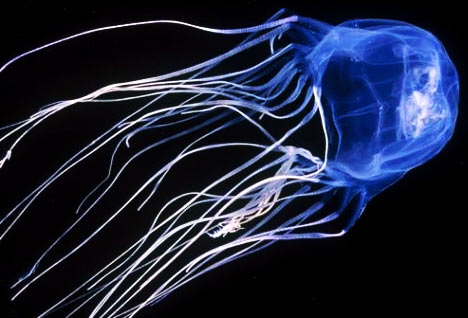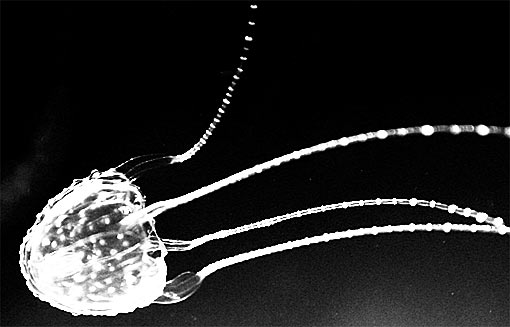Box Jellyfish – The Most Venomous Sea Creature

The box jellyfish are lethal creatures with poison tentacles. They get their name from their box-shaped, translucent bodies, and are in fact sometimes characterized as being the most venomous creatures on earth. They are the most advanced jellyfish, they can even see. They have 24 eyes and four different types of them. The eyes are in different locations, such as one on top and one on the bottom, like above and below cams. They are real swimmers not like other jellyfish who just drift around. They can travel pretty fast, faster than humans. Most of the swimming is probably done in search of food. They may eat up to a quarter of their weight in fish each day. At night they rest or perhaps “sleep”. There are two known dangerous predators among the group, one large, and one small.
The larger one, the Chironex fleckeri (pictured above), is native to Australia’s north coast and Southeast Asian coastlines. They are approximately 1.25 ft (0.38 m) wide. They have sixty tentacles, up to 15 ft (4.6 m) long and 0.25 inches (0.64 cm) in diameter, hanging from the box of the creature. The box of course also contains the eyes and mouth but it doesn’t look like much. They prey on plankton, small fish, and shrimp which they catch in their tentacles and pull into their mouth. The tentacles hold huge numbers of sting cells called nematocysts. When something comes in contact with the tentacles, the nematocysts inject a poison which paralyzes and kills their prey, and can cause extreme pain and even death to large animals or humans. Severe stings may kill a human within four to six minutes after being stung.

The Irukandji is another killer. A tiny member of the box jellyfish family, it has extremely potent venom. It can be the size of a fingernail and almost invisible (you can see it in the right light, pictured above). Its sting may go unnoticed by a human prey until the effects start to manifest. It has only recent been confirmed as the killer of several recreational swimmers off the coast of Australia. Nobody knows how many people may have been killed by its sting without ever knowing what happened to them.
Although various species inhabit most of the world’s tropics, they are not known to be lethal in other waters outside of Australia. In Hawaii for example, they’re not known to kill but their stings can still be extremely painful. Fortunately, their reproductive cycles determine their whereabouts so tracking these events can help us avoid their unpleasant stings.
